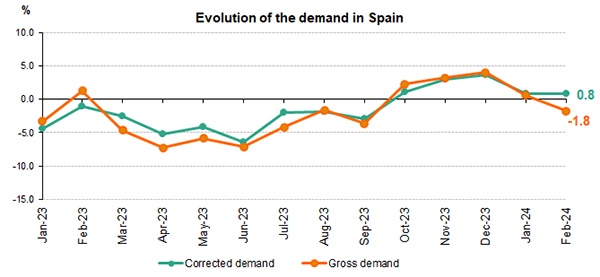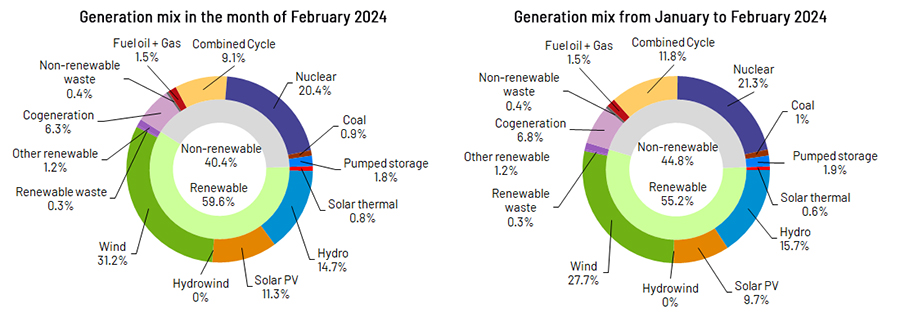For 40 years, we've been driving our country's economic and social progress. Four decades shaping Spain.
Demand for electricity in Spain grew 0.8% in February
- For the fifth consecutive month, wind power production in February continues to lead the generation mix in Spain with a 31.2% share of the total.
- Generation obtained using zero-carbon energy technologies represented 81.4% of the total generation mix nationwide and set an all-time high.
- On 10 February, 88.5% of production was obtained using zero-carbon energy technologies, an all-time record.

National electricity demand in February experienced a 0.8% increase year-on-year after having factored in the influence of seasonal and working patterns. In gross terms, demand is estimated at 20,058 GWh, down 1.8% on February 2023.

In the first two months of 2024, Spain registered a demand of 42,181 GWh, up 0.5% compared to the same period in 2023. Once again, after having factored in the influence of seasonal and working patterns, demand increased by 0.8% compared to the first two months of 2023.
During this month, renewable production was 32.9% higher than in the same month of 2023, reaching 13,152 GWh, representing 59.55% of the total generation mix, a share very close to the record set in November 2023, which was 59.56%.
According to data available at the time of this press release, wind power, which generated 31.2% of the total, was the leading technology for the fifth consecutive month, with a production of 6,901 GWh, a figure that is 47.6% higher than in the same month in 2023.
Rainfall in recent months has enabled hydro to increase its production in February by 31.6% compared to the same month in 2023, which was a very dry year. Thus, hydro generated 3,242 GWh, making it the third technology in the mix this February, with 14.7%.
Solar photovoltaic, with 2,500 GWh recorded in February, increased its production by 16.2% compared to last year, obtaining a share of 11.3%.
Production obtained using zero-carbon energy technologies reached its all-time high this month, generating 81.4% of the total in Spain. On 10 February, it registered a share of 88.5% of the national generation mix.

Demand for electricity in the mainland system increased by 0.5%
Regarding the mainland electricity system, and after having factored in the influence of seasonal and working patterns, demand was 0.5% higher than in February 2023. In gross terms, demand this month was 18,912 GWh, down 2% year-on-year, a variation that is mainly explained by milder temperatures in February 2024.
In the first two months of the year, demand on the mainland stood 39,816 GWh, down 0.7% compared to the same period in 2023. After having factored in the influence of seasonal and working patterns, demand shows an increase of 0.6%.
Renewables on the mainland as a whole generated 61.7% of the total in February, according to data available at the time of this press release, registering a production of 12,980 GWh, a figure that is 32.4% higher than in the same month last year. Production obtained using zero-carbon energy technologies accounted for 84.7% of the total.
The mainland generation mix in February was also led by wind power, which was responsible for 32.2% of the total with a production of 6,790 GWh during the month.
The electricity system in the Balearic Islands and in the Canary Islands
Electricity demand in the Balearic Islands in February was up 1.6% after having factored in the influence of seasonal and working patterns. Thus, gross demand is estimated at 409,881 MWh, down 5.2% year-on-year. In the first two months of 2024, gross demand in the Balearic Islands is estimated at 855,177 MWh, a figure that is 3.1% less than in the same period of 2023.
In terms of generation, combined cycle, with 76.7% of the energy produced in the Balearic Islands, was the leading energy source in the islands in February. For its part, renewable energy obtained using zero-carbon energy technologies in the Balearic Islands represented 11.2% of the total. In addition, during February, the subsea link between the mainland and Majorca contributed to covering 28.1% of the electricity demand in the Balearic Islands.
Meanwhile, after factoring in the influence of seasonal and working patterns, electricity demand in the Canary Islands increased 8.4% year-on-year. In gross terms, demand was 703,903 MWh, up 8.2%. In the first two months of 2024, demand in the Canary Islands is estimated at 1,444,778 MWh, a figure that is 5.5% higher than in the same period of 2023.
In terms of electricity generation in the Canary Islands, combined cycle, with 42% of the total, was also the leading technology in February, while renewables and generation obtained using zero-carbon energy technologies produced 19.7% of the production, with wind power accounting for 15.8%.
Consult our Daily Balance Report for more information on the National, Peninsular, Balearic Islands and Canary Islands electricity systems as at the close of February.
Downloads












